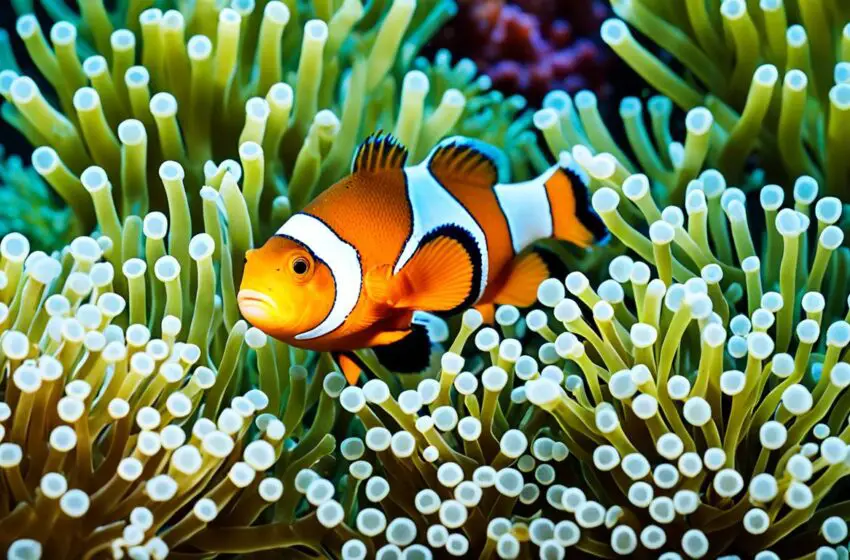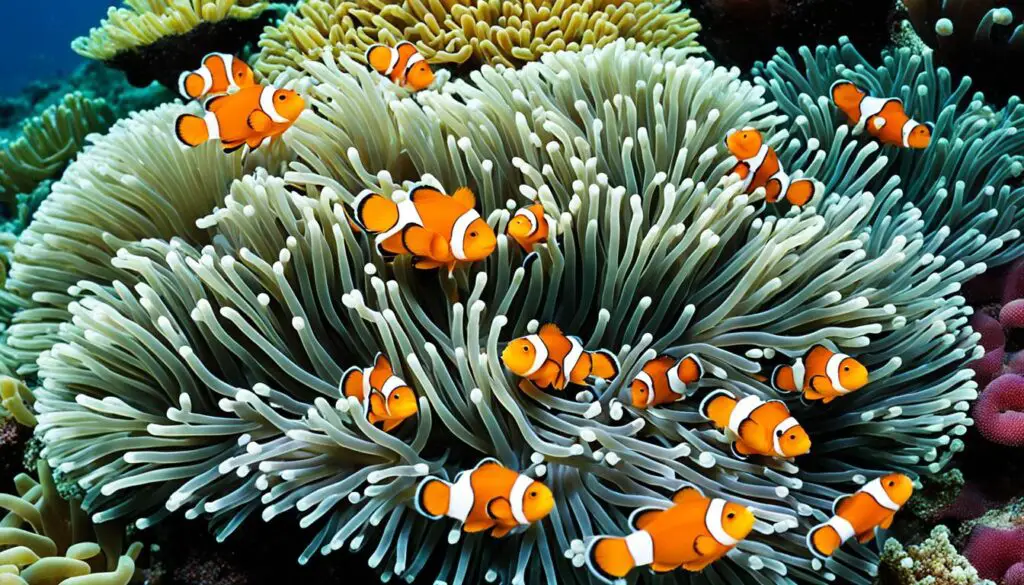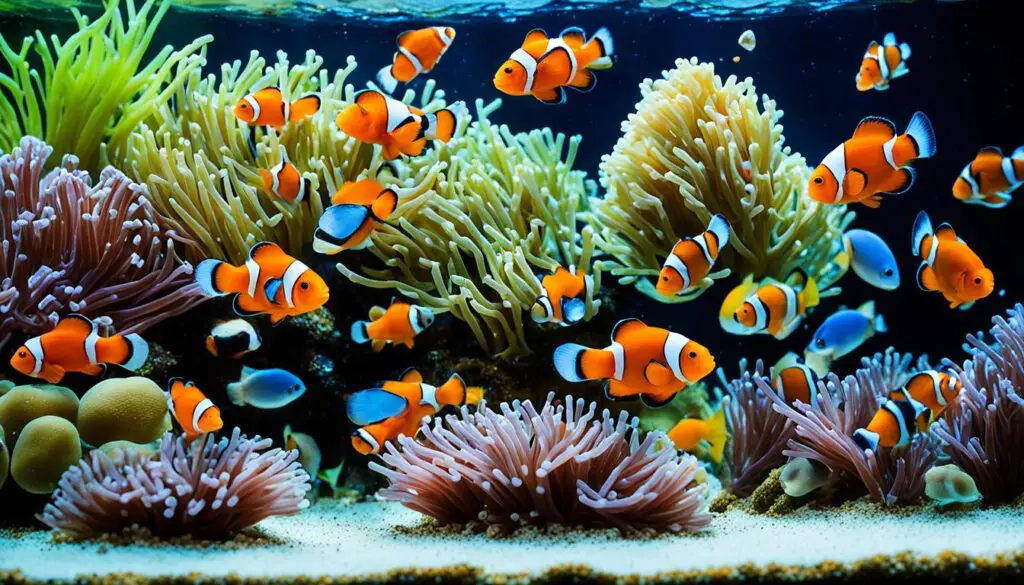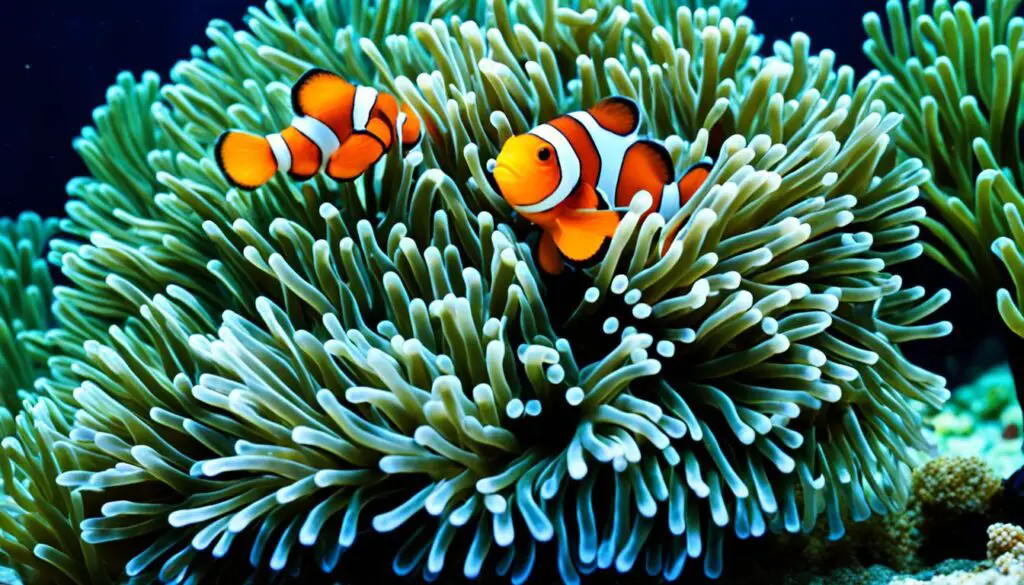Feed Your Clownfish Right: Essential Diet Tips

Welcome to our guide on feeding clownfish the best way! I’m a big fan of these fish. It’s key to make sure they eat well for their health. This is important whether you’re new to fish tanks or have had them for a while.
Clownfish in nature eat many things. This includes things like zooplankton, shrimp, and algae. To feed them well at home, you can use quality fish food, frozen treats, and live snacks. It’s also good to add some seaweed for a balanced diet.
Make sure to have a regular feeding time for your clownfish. They usually eat once each day. But babies or those ready to make more fish might need food more often. Only give them a little food each time, no more than their eye size. This stops the water in the tank from getting dirty.
Keep in mind that baby clownfish eat food that’s very fine. They start by eating things like rotifers. As they grow, they can have crushed pellets or flakes.
Key Takeaways:
- Clownfish eat a mix of foods in the wild, like small animals and algae.
- At home, give them good fish food, snacks, and some seaweed.
- Set up a regular feeding time. Feed once a day, maybe more for young or breeding fish.
- Don’t give them too much food. A portion the size of their eye is enough to stay healthy.
What Do Clownfish Eat in the Wild?
In the wild, clownfish eat from the genera Ampiphrion and Premnas. They work with anemones in a special way, getting food and protection. The anemone gives food by trapping it in its tentacles. A main part of the diet comes from these trapped bits. Clownfish are also omnivores, eating various things like copepods, fish eggs, and tiny shrimp. They even snack on algae. Their broad diet helps make them easy to care for in fish tanks.

The bond between clownfish and anemones is interesting. The anemone keeps the fish safe, and the fish prevent parasites and add nutrients. This connection is key for both to do well. What they eat in the wild clearly relates to this partnership.
Clownfish mainly eat zooplankton, especially copepods. These are tiny sea crustaceans. They also feast on shrimp, fish eggs, and larvae. Algae is a part of their diet too, but not as much as the others.
In their natural habitat, clownfish have a unique way of eating from their anemone hosts, a behavior called “bites.” These bites serve several purposes. They get the fish food and help produce more mucus in the anemone. This mucus helps both the clownfish and the anemone.
Knowing what wild clownfish eat helps us look after them better. By feeding them different kinds of high-quality foods, we can keep our pet clownfish healthy and happy.
| Food sources for clownfish in the wild | |
|---|---|
| Zooplankton (copepods) | Fish eggs |
| Small shrimp | Larvae |
| Algae (to a lesser extent) |
What Do Clownfish Eat in the Aquarium?
In captivity, giving clownfish the right food is crucial for their health and happiness. There are many foods to choose from that can provide what they need.
Suitable Foods for Clownfish
Clownfish need a mix of foods for a complete diet. Ocean-safe pellets or flakes are a top choice because they’re full of key nutrients. Foods like mysis, brine shrimp, and krill add variety and keep things interesting.
Give them fresh brine shrimp sometimes to make them feel at home. Adding vitamins to freeze-dried food can boost their nutrition. Also, they can eat seaweed and algae tabs for their vegetable needs.
Feeding Schedule
Feeding clownfish daily is a good habit. A portion just the size of their eye is enough to keep them healthy. This avoids problems with the water in the tank.
If you’re raising baby clownfish, feed them twice or three times each day. But always remember to take out any uneaten food to keep the water clean.
Introducing New Foods
Try to mix up their diet occasionally to keep them interested and healthy. Frozen foods like brine shrimp can add new flavors and nutrients. They mimic what they would eat in the ocean.
Overall, a varied diet is best for your clownfish. This, combined with a strict feeding schedule, will make them flourish at home.

Conclusion
Keeping a clownfish healthy and happy starts with a proper diet. They need a mix of foods to get all the nutrients they need. Good options include marine pellets, frozen mysis, brine shrimp, and krill. Plus, brine shrimp and freeze-dried foods soaked in vitamins are great.
To mix it up, add in some seaweed or algae. Feed your clownfish once each day. If they’re breeding or young, you can increase this to two or three times. Always watch the portion size; it should be no bigger than their eye. This helps keep the water clean and prevents overfeeding problems.
Understanding a clownfish’s diet and feeding them right makes a big difference. Giving them a variety of foods keeps them happy and colorful. This makes your aquarium a joy to watch. Follow these simple tips to keep your clownfish thriving.
FAQ
What should I feed my clownfish in captivity?
Clownfish should eat a mix of foods like marine pellets, flakes, and frozen items. Include foods like mysis shrimp and krill. Live food, such as brine shrimp, and freeze-dried food are also good. Give them seaweed and algae tabs for vegetable options.
How often should I feed my clownfish?
Feed clownfish once a day. Feed them more if they are breeding or if they’re young. In these times, feeding them two or three times a day is best.
What is the portion size for feeding clownfish?
Give clownfish food that’s about the size of their eye. Be careful not to give them too much to keep the water quality high.
What should I do with leftover food after feeding my clownfish?
Always remove any food left over after feeding. This helps keep the aquarium’s water in good shape.
Can I give my clownfish frozen foods?
Yes, frozen foods like mysis shrimp and krill are great for clownfish. They add new tastes to their diet and keep things interesting.
What is the diet of clownfish in the wild?
In the wild, clownfish eat a wide variety of foods. This includes zooplankton, fish eggs, and even small shrimp. They also eat algae. They get food from anemones too, either from the anemone itself or from the things caught in the anemone’s tentacles.

